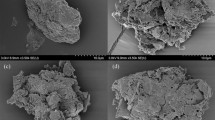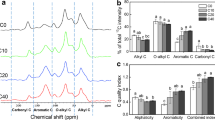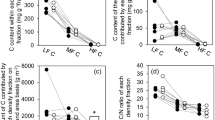Abstract
Aims
This study aimed to explore the mechanisms of the priming effect (PE) induced by root exudates on soil carbon pools at different stages of decomposition.
Methods
The 13 C-labeled and unlabeled glucose, glycine and oxalic acid were added to soils of 15-year old-field (OF), 15-year bare-fallow (BF) and 23-year bare-fallow plus additional 815-day laboratory incubation (BF+), which represented relatively active (OF) and more resistant (BF and BF+) soil carbon pools. The 13 C stable isotope was used to determine the PE and net carbon balance, and cumulative CO2 emission, microbial biomass carbon and dissolved organic carbon were also reported.
Results
Relative to the control, soil organic carbon (SOC) decomposition in OF, BF and BF+ was stimulated by 17.3%, 20.8% and 21.5% with glucose addition, by 12.0%, 36.9% and 52.6% with glycine addition, and by 20.8%, 58.4% and 62.8% with oxalic acid addition, respectively. Overall, oxalic acid resulted in higher cumulative PE and lower net carbon balance relative to glucose and glycine in all three soils. Moreover, the PE of BF and BF+ were larger than that of OF induced by glucose, glycine and oxalic acid.
Conclusions
Resistant soil carbon is more vulnerable to priming by root exudates compared to active soil carbon, and oxalic acid can induce a stronger PE than glucose and glycine, especially in more resistant soil carbon pools.







Similar content being viewed by others
Abbreviations
- OF:
-
old-field
- BF:
-
bare-fallow
- BF+:
-
bare-fallow+incubation
- C:
-
carbon
- SOC:
-
soil organic carbon
- SOM:
-
soil organic matter
- TC:
-
total carbon
- TOC:
-
total organic carbon
- N:
-
nitrogen
- WHC:
-
water-holding capacity
- PE:
-
priming effect
- MBC:
-
microbial biomass carbon
- DOC:
-
dissolved organic carbon
References
Barré P, Plante AF, Cécillon L, Lutfalla S, Baudin F, Bernard S, Christensen BT, Eglin T, Fernandez JM, Houot S, Kätterer T, Le Guillou C, Macdonald A, van Oort F, Chenu C (2016) The energetic and chemical signatures of persistent soil organic matter. Biogeochemistry 130:1–12. https://doi.org/10.1007/s10533-016-0246-0
Baumert VL, Vasilyeva NA, Vladimirov AA, Meier IC, Kögel-Knabner I, Mueller CW (2018) Root exudates induce soil macroaggregation facilitated by fungi in subsoil. Front Environ Sci 6:140. https://doi.org/10.3389/fenvs.2018.00140
Bernal B, McKinley DC, Hungate BA, White PM, Mozdzer TJ, Megonigal JP (2016) Limits to soil carbon stability; Deep, ancient soil carbon decomposition stimulated by new labile organic inputs. Soil Biol Biochem 98:85–94. https://doi.org/10.1016/j.soilbio.2016.04.007
Blagodatskaya E, Blagodatsky S, Anderson T-H, Kuzyakov Y (2007) Priming effects in Chernozem induced by glucose and N in relation to microbial growth strategies. Appl Soil Ecol 37:95–105. https://doi.org/10.1016/j.apsoil.2007.05.002
Blagodatskaya Е, Kuzyakov Y (2008) Mechanisms of real and apparent priming effects and their dependence on soil microbial biomass and community structure: Critical review. Biol Fertil Soils 45:115–131. https://doi.org/10.1007/s00374-008-0334-y
Blagodatskaya E, Blagodatsky S, Dorodnikov M, Kuzyakov Y (2010) Elevated atmospheric CO2 increases microbial growth rates in soil: Results of three CO2 enrichment experiments. Glob Chang Biol 16:836–848. https://doi.org/10.1111/j.1365-2486.2009.02006.x
Blagodatskaya E, Yuyukina T, Blagodatsky S, Kuzyakov Y (2011) Turnover of soil organic matter and of microbial biomass under C3-C4 vegetation change: Consideration of 13 C fractionation and preferential substrate utilization. Soil Biol Biochem 43:159–166. https://doi.org/10.1016/j.soilbio.2010.09.028
Blagodatskaya E, Kuzyakov Y (2013) Active microorganisms in soil: Critical review of estimation criteria and approaches. Soil Biol Biochem 67:192–211. https://doi.org/10.1016/j.soilbio.2013.08.024
Blagodatskaya E, Khomyakov N, Myachina O, Bogomolova I, Blagodatsky S, Kuzyakov Y (2014) Microbial interactions affect sources of priming induced by cellulose. Soil Biol Biochem 74:39–49. https://doi.org/10.1016/j.soilbio.2014.02.017
Broeckling CD, Broz AK, Bergelson J, Manter DK, Vivanco JM (2008) Root exudates regulate soil fungal community composition and diversity. Appl Environ Microbiol 74:738–744. https://doi.org/10.1128/AEM.02188-07
Chen R, Senbayram M, Blagodatsky S, Myachina O, Dittert K, Lin X, Blagodatskaya E, Kuzyakov Y (2014) Soil C and N availability determine the priming effect: Microbial N mining and stoichiometric decomposition theories. Glob Chang Biol 20:2356–2367. https://doi.org/10.1111/gcb.12475
Chen L, Liu L, Qin S, Yang G, Fang K, Zhu B, Kuzyakov Y, Chen P, Xu Y, Yang Y (2019) Regulation of priming effect by soil organic matter stability over a broad geographic scale. Nat Commun 10:5112–5112. https://doi.org/10.1038/s41467-019-13119-z
Cheng W, Parton WJ, Gonzalez-Meler MA, Phillips R, Asao S, McNickle GG, Brzostek E, Jastrow JD (2014) Synthesis and modeling perspectives of rhizosphere priming. New Phytol 201:31–44. https://doi.org/10.1111/nph.12440
Clarholm M, Skyllberg U, Rosling A (2015) Organic acid induced release of nutrients from metal-stabilized soil organic matter -The unbutton model. Soil Biol Biochem 84:168–176. https://doi.org/10.1016/j.soilbio.2015.02.019
Davidson EA, Janssens IA (2006) Temperature sensitivity of soil carbon decomposition and feedbacks to climate change. Nature 440:165–173. https://doi.org/10.1038/nature04514
de Graaff M-A, Classen AT, Castro HF, Schadt CW (2010) Labile soil carbon inputs mediate the soil microbial community composition and plant residue decomposition rates. New Phytol 188:1055–1064. https://doi.org/10.1111/j.1469-8137.2010.03427.x
Demyan MS, Rasche F, Schulz E, Breulmann M, Müller T, Cadisch G (2012) Use of specific peaks obtained by diffuse reflectance Fourier transform mid-infrared spectroscopy to study the composition of organic matter in a Haplic Chernozem. Eur J Soil Sci 63:189–199. https://doi.org/10.1111/j.1365-2389.2011.01420.x
Dijkstra FA, Carrillo Y, Pendall E, Morgan JA (2013) Rhizosphere priming: A nutrient perspective. Front Microbiol 4:216. https://doi.org/10.3389/fmicb.2013.00216
Drake JE, Darby BA, Giasson M-A, Kramer MA, Phillips RP, Finzi AC (2013) Stoichiometry constrains microbial response to root exudation- insights from a model and a field experiment in a temperate forest. Biogeosciences 10:821–838. https://doi.org/10.5194/bg-10-821-2013
Dungait JAJ, Hopkins DW, Gregory AS, Whitmore AP (2012) Soil organic matter turnover is governed by accessibility not recalcitrance. Glob Change Biol 18:1781–1796. https://doi.org/10.1111/j.1365-2486.2012.02665.x
Falchini L, Naumova N, Kuikman PJ, Bloem J, Nannipieri P (2003) CO2 evolution and denaturing gradient gel electrophoresis profiles of bacterial communities in soil following addition of low molecular weight substrates to simulate root exudation. Soil Biol Biochem 35:775–782. https://doi.org/10.1016/S0038-0717(03)00105-6
Feng J, Zhu B (2021) Global patterns and associated drivers of priming effect in response to nutrient addition. Soil Biol Biochem 153:108118. https://doi.org/10.1016/j.soilbio.2020.108118
Fischer H, Kuzyakov Y (2010) Sorption, microbial uptake and decomposition of acetate in soil: Transformations revealed by position-specific 14 C labeling. Soil Biol Biochem 42:186–192. https://doi.org/10.1016/j.soilbio.2009.10.015
Fontaine S, Mariotti A, Abbadie L (2003) The priming effect of organic matter: A question of microbial competition? Soil Biol Biochem 35:837–843. https://doi.org/10.1016/S0038-0717(03)00123-8
Fontaine S, Bardoux G, Abbadie L, Mariotti A (2004) Carbon input to soil may decrease soil carbon content. Ecol Lett 7:314–320. https://doi.org/10.1111/j.1461-0248.2004.00579.x
Fontaine S, Barot S, Barré P, Bdioui N, Mary B, Rumpel C (2007) Stability of organic carbon in deep soil layers controlled by fresh carbon supply. Nature 450:277–280. https://doi.org/10.1038/nature06275
Fontaine S, Henault C, Aamor A, Bdioui N, Bloor JMG, Maire V, Mary B, Revaillot S, Maron PA (2011) Fungi mediate long term sequestration of carbon and nitrogen in soil through their priming effect. Soil Biol Biochem 43:86–96. https://doi.org/10.1016/j.soilbio.2010.09.017
Guenet B, Juarez S, Bardoux G, Abbadie L, Chenu C (2012) Evidence that stable C is as vulnerable to priming effect as is more labile C in soil. Soil Biol Biochem 52:43–48. https://doi.org/10.1016/j.soilbio.2012.04.001
Guenet B, Camino-Serrano M, Ciais P, Tifafi M, Maignan F, Soong JL, Janssens IA (2018) Impact of priming on global soil carbon stocks. Glob Chang Biol 24:1873–1883. https://doi.org/10.1111/gcb.14069
Haichar FZ, Santaella C, Heulin T, Achouak W (2014) Root exudates mediated interactions belowground. Soil Biol Biochem 77:69–80. https://doi.org/10.1016/j.soilbio.2014.06.017
Hamer U, Marschner B (2005) Priming effects in different soil types induced by fructose, alanine, oxalic acid and catechol additions. Soil Biol Biochem 37:445–454. https://doi.org/10.1016/j.soilbio.2004.07.037
Hessen DO, Ågren GI, Anderson TR, Elser JJ, de Ruiter PC (2004) Carbon sequestration in ecosystems: The role of stoichiometry. Ecology 85:1179–1192. https://doi.org/10.1890/02-0251
Huang SS, Huo CF, Xie HT, Wang P, Cheng WX (2019) Soil organic carbon mineralization and priming effects in the topsoil and subsoil under no-tillage black soil. J Appl Ecol 30:1877–1884. https://doi.org/10.13287/j.1001-9332.201906.015
IPCC (2013) Climate change 2013. The physical science basis: Working Group I contribution to the Fifth assessment report of the Intergovernmental Panel on Climate Change. Cambridge University Press, Cambridge
Jones C, McConnell C, Coleman K, Cox P, Falloon P, Jenkinson D, Powlson D (2005) Global climate change and soil carbon stocks; predictions from two contrasting models for the turnover of organic carbon in soil. Glob Chang Biol 11:154–166. https://doi.org/10.1111/j.1365-2486.2004.00885.x
Keiluweit M, Bougoure JJ, Nico PS, Pett-Ridge J, Weber PK, Kleber M (2015) Mineral protection of soil carbon counteracted by root exudates. Nat Clim Chang 5:588–595. https://doi.org/10.1038/NCLIMATE2580
Kirschbaum MUF (2004) Soil respiration under prolonged soil warming: Are rate reductions caused by acclimation or substrate loss? Glob. Chang Biol 10:1870–1877. https://doi.org/10.1111/j.1365-2486.2004.00852.x
Kuzyakov Y, Friedel JK, Stahr K (2000) Review of mechanisms and quantification of priming effects. Soil Biol Biochem 32:1485–1498. https://doi.org/10.1016/S0038-0717(00)00084-5
Kuzyakov Y, Bol R (2006) Sources and mechanisms of priming effect induced in two grassland soils amended with slurry and sugar. Soil Biol Biochem 38:747–758. https://doi.org/10.1016/j.soilbio.2005.06.025
Lefèvre R, Barré P, Moyano FE, Christensen BT, Bardoux G, Eglin T, Girardin C, Houot S, Kätterer T, van Oort F, Chenu C (2014) Higher temperature sensitivity for stable than for labile soil organic carbon-Evidence from incubations of long-term bare fallow soils. Glob Chang Biol 20:633–640. https://doi.org/10.1111/gcb.12402
Liang J, Zhou Z, Huo C, Shi Z, Cole JR, Huang L, Konstantinidis KT, Li X, Liu B, Luo Z, Penton CR, Schuur EAG, Tiedje JM, Wang Y-P, Wu L, Xia J, Zhou J, Luo Y (2018) More replenishment than priming loss of soil organic carbon with additional carbon input. Nat Commun 9:3175. https://doi.org/10.1038/s41467-018-05667-7
Liu X-JA, Sun J, Mau RL, Finley BK, Compson ZG, van Gestel N, Brown JR, Schwartz E, Dijkstra P, Hungate BA (2017) Labile carbon input determines the direction and magnitude of the priming effect. Appl Soil Ecol 109:7–13. https://doi.org/10.1016/j.apsoil.2016.10.002
Morris SJ, Allen MF (1994) Oxalate-metabolizing microorganisms in sagebrush steppe soil. Biol Fertil Soils 18:255–259. https://doi.org/10.1007/BF00647677
Pausch J, Kuzyakov Y (2018) Carbon input by roots into the soil: Quantification of rhizodeposition from root to ecosystem scale. Glob Chang Biol 24:1–12. https://doi.org/10.1111/gcb.13850
Qiao N, Schaefer D, Blagodatskaya E, Zou X, Xu X, Kuzyakov Y (2014) Labile carbon retention compensates for CO2 released by priming in forest soils. Glob Chang Biol 20:1943–1954. https://doi.org/10.1111/gcb.12458
Qiu Q, Wu L, Li B, Xu Y (2020) Spatiotemporal variations in soil CO2 fluxes under a winter wheat-summer maize cropping system in the North China Plain. Nutr Cycl Agroecosys 117:103–119. https://doi.org/10.1007/s10705-020-10053-1
Tian P, Mason-Jones K, Liu S, Wang Q, Sun T (2019) Form of nitrogen deposition affects soil organic matter priming by glucose and cellulose. Biol Fertil Soils 55:383–391. https://doi.org/10.1007/s00374-019-01357-8
Wei L, Razavi BS, Wang W, Zhu Z, Liu S, Wu J, Kuzyakov Y, Ge T (2019) Labile carbon matters more than temperature for enzyme activity in paddy soil. Soil Biol Biochem 135:134–143. https://doi.org/10.1016/j.soilbio.2019.04.016
Wild B, Schnecker J, Alves RJE, Barsukov P, Bárta J, Capek P, Gentsch N, Gittel A, Guggenberger G, Lashchinskiy N, Mikutta R, Rusalimova O, Santrůčková H, Shibistova O, Urich T, Watzka M, Zrazhevskaya G, Richter A (2014) Input of easily available organic C and N stimulates microbial decomposition of soil organic matter in arctic permafrost soil. Soil Biol Biochem 75:143–151. https://doi.org/10.1016/j.soilbio.2014.04.014
Wu J, Brookes PC, Jenkinson DS (1993) Formation and destruction of microbial biomass during the decomposition of glucose and ryegrass in soil. Soil Biol Biochem 25:1435–1441. https://doi.org/10.1016/0038-0717(93)90058-J
Zhang X, Han X, Yu W, Wang P, Cheng W (2017) Priming effects on labile and stable soil organic carbon decomposition: Pulse dynamics over two years. PLoS ONE 12:e0184978. https://doi.org/10.1371/journal.pone.0184978
Zhang Z, Wang W, Qi J, Zhang H, Tao F, Zhang R (2019) Priming effects of soil organic matter decomposition with addition of different carbon substrates. J Soils Sediment 19:1171–1178. https://doi.org/10.1007/s11368-018-2103-3
Zhu B, Cheng W (2011) Rhizosphere priming effect increases the temperature sensitivity of soil organic matter decomposition. Glob Chang Biol 17:2172–2183. https://doi.org/10.1111/j.1365-2486.2010.02354.x
Acknowledgements
This work was supported by the National Natural Science Foundation of China (31770529 and 31971528), the Science and Technology Research Program of Chongqing Municipal Education Commission (KJZD-K202001203, KJZD-K202003501), the Chongqing Science and Technology Commission (cstc2020jcyj-msxmX0095). We thank Shuai Zhang, Xi Chen and Zhuolin Yu for laboratory assistance. We also sincerely thank the anonymous reviewers for their helpful comments and suggestions which greatly improved the manuscript.
Author information
Authors and Affiliations
Corresponding authors
Ethics declarations
The authors declare that they have no known competing financial interests or personal relationships that could have appeared to influence the work reported in this paper.
Additional information
Responsible Editor: Lucas Silva
Publisher’s Note
Springer Nature remains neutral with regard to jurisdictional claims in published maps and institutional affiliations.
Supplementary Information
ESM 1
(DOCX 1183 kb)
Rights and permissions
About this article
Cite this article
Zhou, S., Lin, J., Wang, P. et al. Resistant soil organic carbon is more vulnerable to priming by root exudate fractions than relatively active soil organic carbon. Plant Soil 488, 71–82 (2023). https://doi.org/10.1007/s11104-021-05288-y
Received:
Accepted:
Published:
Issue Date:
DOI: https://doi.org/10.1007/s11104-021-05288-y




